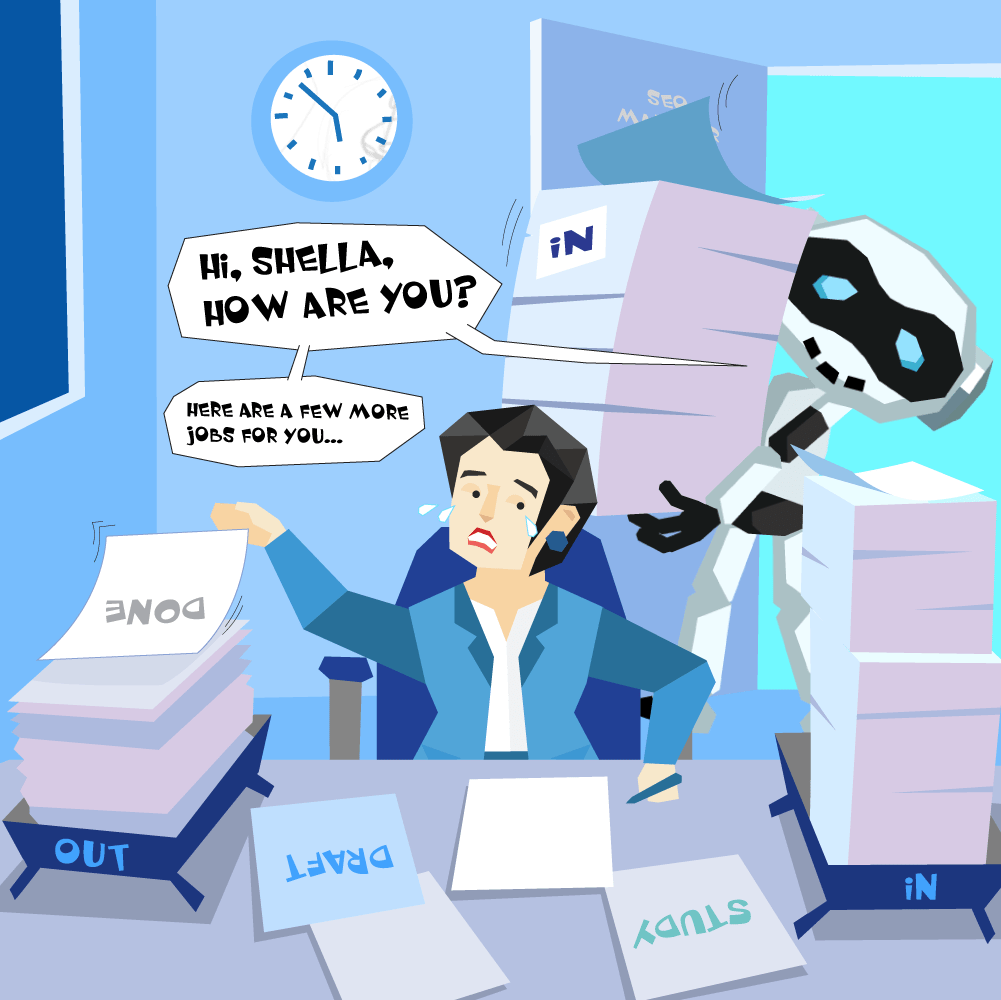Upgrade Your Website Content For Google & Your Prospects

As the backbone of your online marketing efforts, the content that lives on your website is vital to achieving your marketing and sales goals. Without good content (or without content in general), there’s very little reason people visit your website, especially if they are unfamiliar with your brand or the products or services you have to offer. Because of the critical part that content plays in your website’s success, your site should be upgraded continuously with new content and your old content updated to ensure that it remains relevant and useful.
When upgrading your website content, you must focus on Google and the audience you’re targeting. Many businesses make the mistake of only focusing their efforts on one or the other. On the one hand, your website’s content needs to be correctly optimized to rank well on Google’s search engine. On the other, it needs to be relevant and useful to the audience you’re targeting. If your content does one but not the other, it will inevitably affect its performance.
We’ve put together a guide to upgrade your existing content and enhance your current content strategy. This guide will help ensure that the new content you publish will be successful.
Benefits Of Upgrading Your Website Content
Your website might already be packed to the brim with what you perceive to be high-quality content. Maybe your site has been up and running for years. Maybe every page is filled with content that’s relevant to your audience. Perhaps you have hundreds of articles posted to your blog page. You may have maintained a steady stream of traffic from a variety of different sources. But while your content strategy may be successful at the moment, you should still look for ways to upgrade your website content.
By upgrading your website content, you’ll have a better chance of continuing that success throughout the future and improving upon it. Here are a few of the significant benefits that you could enjoy due to upgrading your website content:
Improve SEO
Google continually updates its algorithm, which means that your SEO optimization efforts may grow outdated, depending on how old your content is. Google takes into account the “freshness” of content, meaning that it sees newer content as more relevant. By upgrading content, you automatically improve its freshness — and by going back and improving the SEO optimization of older content, you can improve your page rankings.
Increase Quality
There’s a chance that your older content lacks quality compared to your newer content. Rewriting or expanding older content will help to improve its quality. By improving your content quality, you can increase user engagement, which boosts your page rankings.
Update Statistics And Facts
You may have used statistics and facts in older content that are now outdated or inaccurate. If you leave this information as is, it will hurt your brand authority. Check your use of statistics and facts periodically and update them when necessary. Then you’ll be sure you’re not providing inaccurate information to your audience.
Improve Performance
A lot of effort goes into the creation of content. If your content isn’t performing well, you shouldn’t just write it off as a loss. Upgrading content can help to improve its performance and increase your content marketing strategy’s overall ROI.
Maintain Consistency
Upgrading older content will ensure that it’s consistent with the quality, tone, and brand message of the content you are currently producing. Consistency is essential to your ability to nurture leads through the buyer’s journey and establish a strong brand identity.
Maintain And Grow Existing Audience
It’s not enough to just upgrade existing website content. Your website will be improved by adding new content regularly. By adding new content, you can keep your existing audience engaged while also growing your audience by attracting new visitors.
1. Determine Whether Your Content Needs To Be Upgraded
Not all of your website content needs to be upgraded. Some of your website content, especially recent content that’s performing well could be acceptable as is. If you only recently launched your website, it may be too soon to upgrade your content. However, if your website has been live for some time, and you’ve yet to revisit your site’s content, it may be time.
One thing to note is that while older content can often benefit from an upgrade, you may find that the new content you’re publishing isn’t performing as expected. If this is the case, it may indicate that you need to reassess your existing content strategy. If you’re not publishing any new content, then you know right off the bat that your website content needs to be upgraded. The following tips will tell you whether your website content needs to be updated:
Conduct An SEO Audit
How your content is performing on Google will generally indicate whether it requires an upgrade or not. Google’s algorithm relies heavily on user engagement to determine the quality of the content it’s ranking. If your visitors aren’t engaging with your content, it won’t perform well — and if visitors aren’t engaging, it probably means your content needs work. One of the first things you should do is conduct an SEO audit of your entire website, page-by-page. Doing so will help you identify what content is performing poorly on Google and the likely reason why. A thorough SEO audit should consist of the following:
Identify Technical Issues
User experience is essential to engagement. Poor user experience will drive visitors away, which is why resolving technical issues is so important. Things like outdated plugins and themes, slow loading pages, broken plugins, and broken links all hinder user experience. You will need to identify and correct these issues as they are affecting your SEO.
Identify Design Issues
Design issues leave a terrible first impression on visitors. If you fail to leave a good impression, your visitors will be less likely to remain on your site, much less convert. Address design issues, such as low-quality images, poor formatting, and more — all of which are more likely to plague your website’s older content.
Check Keyword Relevance
Older content might not have been optimized using the best keywords if your understanding of SEO wasn’t as advanced as today. Go back and check the keywords you used for existing content to determine if those keywords are still relevant and competitive. There may be better keyword options that you can target without having to rewrite the entire page.
Determine Content Depth
Long-form content ranks better than short-form content. Studies have proven this time and time again. The reason is simple: long-form content can go in-depth on a subject, which short-form content cannot do. Short-form content just won’t cut it for building brand authority. Visitors are less likely to engage with shorter content, so you should look for any content that appears too shallow. Shallow content will limit how well your page can rank.
Update Buyer Personas If Needed
You may think you have a good idea of who your target audience is, but when was the last time you updated your buyer personas? Audiences change over time, which means that the customers buying your products or services today may be different from past customers. For instance, your audience’s change may have occurred if there was a shift in your branding strategy. Revisiting your buyer personas will ensure that they accurately reflect your current audience. Updating your buyer personas is essential because it will inform any content upgrades you make. When upgrading existing content, make sure it targets the appropriate buyer personas. You don’t want to target a persona that is outdated since this will render your content irrelevant.
Research The Competition
Other businesses within your industry will have content marketing strategies in place, as well. These businesses include both non-competitors and direct competitors. A deep dive into their website content will give you an idea of what you’re up against. Even companies that may not be directly competing with you should be considered competition since they are bidding for brand authority within the same space. By doing your research, you can identify what’s working and not working for other businesses. This information can help inform your strategy for upgrading your existing content.
Analyze Your Data
Use your analytics tools to evaluate the performance of your existing content. Metrics such as page visits, traffic sources, comments, shares, backlinks earned, click-through-rates, and more can give you a good idea of how effective your content is. Not only will digging into your KPIs help you identify website content that’s performing poorly (and therefore likely in need of an upgrade), but you’ll also be able to figure out what content is doing well. By identifying successful content, you can determine what made that content successful and apply those elements to your content upgrades.
2. Define Your Content Value
Once you’ve determined that your website content needs to be upgraded, you will need to define your content’s value. You can’t begin to update content without understanding what it is that will make it better. Remember, the whole point behind a website content upgrade is to improve your content’s performance on Google’s search engine and increase its value to your target audience.
When defining your content value, determine what your value proposition is. Basically, what value are you promising to your audience, and how does it differ from other similar businesses? Your value proposition should drive all of your marketing efforts, including your content marketing. Look at each piece of content on an individual basis to determine value. What exactly is your content providing to your audience?
Types of content that tend to provide real value include how-to guides, product demonstrations, and case studies, to name just a few. Content that does not offer value may consist of old blog posts advertising a sale that has long since come and gone, or blog posts focusing on news or information that’s not relevant to your audience. For example, if your business sells small business software solutions, publishing a blog post on the Oscars provides zero value to your audience.
3. Create New Content
New content is essential if you want to continue to rank well on Google and to continue attracting new leads. One of the factors that Google takes into account when ranking content is “freshness.” Freshness refers to how recent the content is. More recent content tends to be more relevant to user queries, which is why Google rewards websites with fresh content. Publishing new content regularly can also help you maintain a regular audience. People who like your content will continue to return to read new content. If you don’t routinely publish original content, they may not come back. Creating new content will help you maintain visibility and keep your brand at the top of mind.
Evaluate your existing content to determine whether there are any subjects, concerns, questions, or needs that your target audience has that your website does not address. Be sure to create content that fills these gaps, so you don’t lose potential leads, especially those in the buyer’s journey awareness stage. Such leads will go to another website that offers the content they’re looking for.
4. Update Existing Content
The older your content is, the less relevant it generally becomes. By updating your existing content, you can help it retain relevance. Watch for these items to update when evaluating your website’s existing content:
- Outdated facts and information – Good content often uses statistics or data that helps back the point it’s trying to make. Over time, this information may become outdated. Double-check any information specific to a previous time and replace it with any newer data that may exist. You should also update general information that may no longer be true, such as old legal information. If your existing content relies on facts that are outdated or no longer accurate, it will reflect poorly on your reputation. Even updating the publish date may help boost your page’s ranking in search results.
- Outdated page elements – If your website has been around for a while, then some of your content may be visually outdated. For instance, the page itself may have an older layout that uses a different color scheme and font than your newer content. The images you used may be of low quality. You should update these elements so that your older content remains consistent with the look and standards of the new content you publish.
- Outdated CTA – Check the CTAs of your existing content. If your organization’s contact information changed at some point, you need to update your CTAs. Also, evaluate the links in your CTAs. Your offers may no longer be valid. You may even want to replace your offer with something more relevant. For example, if you recently created an eBook that you think is relevant to the subject of an old blog post, you may want to change your CTA’s offer to that eBook download.
- SEO – The best SEO practices change over time as Google continues to improve its algorithm. Older content may need to be re-optimized. Identify how your older content’s keywords are performing and perform additional keyword research. You may find better keywords that you can use to re-optimize your content. You should also check all of your links. Broken links need replacing. You may also want to add more internal links to newer content if it’s relevant.
- Shallow content – Some of your site content may be shorter and more general than you realize. The odds are that your understanding of content marketing has strengthened over the years. You now know that longer, more in-depth content performs better. Consider going back and expanding on existing content on the shorter side to provide greater value to your audience.
- Inconsistent voice or tone – If your brand or target audience has changed over time, you will need to revise your older content’s tone. Otherwise, your older content will be inconsistent in tone to your newer content, which will hurt your branding efforts. A strong brand identity relies on consistency in style and voice across your website.
5. Integrate Video Marketing
If your website consists entirely of written content, then strongly consider upgrading your site with video content. Although video content is a little more expensive to produce, you’ll find that it will perform much better. Audiences have an easier time engaging with video content because it’s easier to consume, especially when it comes to mobile devices. Audiences are also much more likely to share video content than written content, which can help expose your content to a broader audience and bring in new leads.
While creating new video content for your website is a must, you can also integrate videos with existing content. For instance, if you have an older how-to article on your blog, you could film a short video demonstrating some more complicated steps. Videos will add even more value to your older content.
Consider Other Multimedia Elements
Written content isn’t always easy on the eyes, especially long-form content. One way to break it up and make it easier to scan and make it visually more interesting is to add other multimedia elements. Adding videos to all of your old content may not be feasible; however, adding higher resolution images, infographics, and graphs can provide value to existing content. Just make sure that any multimedia elements you add are compressed so that they don’t hurt your site’s user experience by slowing down your pages.
6. Organize Your Content Using Content Silos
A healthy site structure is essential to your content’s success. If your existing content isn’t organized, consider implementing content silos. Content silos help organize your site’s content around general topics, making it easier for visitors to explore specific subjects and find what they’re looking for. Besides making it easier to navigate and explore your site, structuring your content into content silos will make it easier for Google to crawl through your website. Google will have an easier time identifying the subject of your content as well as its context. Content silos also allow Google to identify related content on your website with ease.
7. Test Your Upgraded Pages
Don’t assume that once you’ve upgraded your website that your content upgrade tasks are complete. Continue to test your pages to determine whether your upgrades have improved their performance or not. You can track metrics like number of visits, time on page, number of shares and likes, comments, click-through rates, and conversions. By monitoring how your audience engages with your upgraded content, you can also identify what changes have the most significant impact. This information will come in handy the next time you upgrade your site’s content and publish new content.
Upgrade Your Website Content To Keep Pages Relevant
Old website content can still have a significant impact as long as it remains relevant, so upgrading your site’s content is critical to your marketing efforts. Visitors may be introduced to your website through older content. If it’s outdated in any way, it can reflect poorly on your site, not to mention your organization. As a result, you could lose potential leads. By upgrading your content, you improve its value to your audience and help boost your presence on Google’s search engine, which will help you bring in more traffic and capture more leads.
In the end, upgrading your website’s content will help ensure that all of the content living on your site is consistent with the standards of quality you’ve established. Keeping your older content relevant is vital to this consistency.









